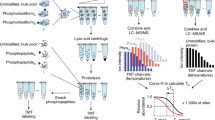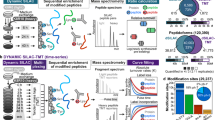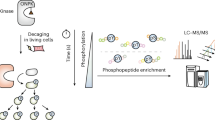Abstract
Although the biological significance of protein phosphorylation in cellular signaling is widely appreciated, methods to directly detect these post-translational modifications in situ are lacking. Here we introduce the application of high-resolution NMR spectroscopy for observing de novo protein phosphorylation in vitro and in Xenopus laevis egg extracts and whole live oocyte cells. We found that the stepwise modification of adjacent casein kinase 2 (CK2) substrate sites within the viral SV40 large T antigen regulatory region proceeded in a defined order and through intermediate substrate release. This kinase mechanism contrasts with a more intuitive mode of CK2 action in which the kinase would remain substrate bound to perform both modification reactions without intermediate substrate release. For cellular signaling pathways, the transient availability of partially modified CK2 substrates could exert important switch-like regulatory functions.
This is a preview of subscription content, access via your institution
Access options
Subscribe to this journal
Receive 12 print issues and online access
$189.00 per year
only $15.75 per issue
Buy this article
- Purchase on Springer Link
- Instant access to full article PDF
Prices may be subject to local taxes which are calculated during checkout







Similar content being viewed by others
References
Salih, E. Phosphoproteomics by mass spectrometry and classical protein chemistry approaches. Mass Spectrom. Rev. 24, 828–846 (2005).
Landrieu, I. et al. NMR analysis of a Tau phosphorylation pattern. J. Am. Chem. Soc. 128, 3575–3583 (2006).
Pinna, L.A. Protein kinase CK2: a challenge to canons. J. Cell Sci. 115, 3873–3878 (2002).
Meggio, F. & Pinna, L.A. One-thousand-and-one substrates of protein kinase CK2? FASEB J. 17, 349–368 (2003).
Hubner, S., Xiao, C.Y. & Jans, D.A. The protein kinase CK2 site (Ser111/112) enhances recognition of the simian virus 40 large T-antigen nuclear localization sequence by importin. J. Biol. Chem. 272, 17191–17195 (1997).
Rihs, H.P., Jans, D.A., Fan, H. & Peters, R. The rate of nuclear cytoplasmic protein transport is determined by the casein kinase II site flanking the nuclear localization sequence of the SV40 T-antigen. EMBO J. 10, 633–639 (1991).
Kuenzel, E.A., Mulligan, J.A., Sommercorn, J. & Krebs, E.G. Substrate specificity determinants for casein kinase II as deduced from studies with synthetic peptides. J. Biol. Chem. 262, 9136–9140 (1987).
Zhou, P., Lugovskoy, A.A. & Wagner, G. A solubility-enhancement tag (SET) for NMR studies of poorly behaving proteins. J. Biomol. NMR 20, 11–14 (2001).
Bienkiewicz, E.A. & Lumb, K.J. Random-coil chemical shifts of phosphorylated amino acids. J. Biomol. NMR 15, 203–206 (1999).
Ellis, R.J. Macromolecular crowding: an important but neglected aspect of the intracellular environment. Curr. Opin. Struct. Biol. 11, 114–119 (2001).
Minton, A.P. The influence of macromolecular crowding and macromolecular confinement on biochemical reactions in physiological media. J. Biol. Chem. 276, 10577–10580 (2001).
Murray, A.W. Cell cycle extracts. Methods Cell Biol. 36, 581–605 (1991).
Wilhelm, V., Rojas, P., Gatica, M., Allende, C.C. & Allende, J.E. Expression of the subunits of protein kinase CK2 during oogenesis in Xenopus laevis. Eur. J. Biochem. 232, 671–676 (1995).
Jans, D.A., Ackermann, M.J., Bischoff, J.R., Beach, D.H. & Peters, R. p34cdc2-mediated phosphorylation at T124 inhibits nuclear import of SV-40 T antigen proteins. J. Cell Biol. 115, 1203–1212 (1991).
Ferrell, J.E., Jr. Xenopus oocyte maturation: new lessons from a good egg. Bioessays 21, 833–842 (1999).
Ubersax, J.A. & Ferrell, J.E., Jr. Mechanisms of specificity in protein phosphorylation. Nat. Rev. Mol. Cell Biol. 8, 530–541 (2007).
Gautier, J., Matsukawa, T., Nurse, P. & Maller, J. Dephosphorylation and activation of Xenopus p34cdc2 protein kinase during the cell cycle. Nature 339, 626–629 (1989).
Selenko, P., Serber, Z., Gadea, B., Ruderman, J. & Wagner, G. Quantitative NMR analysis of the protein G B1 domain in Xenopus laevis egg extracts and intact oocytes. Proc. Natl. Acad. Sci. USA 103, 11904–11909 (2006).
Ferrell, J.E., Jr. & Bhatt, R.R. Mechanistic studies of the dual phosphorylation of mitogen-activated protein kinase. J. Biol. Chem. 272, 19008–19016 (1997).
Niefind, K., Yde, C.W., Ermakova, I. & Issinger, O.G. Evolved to be active: sulfate ions define substrate recognition sites of CK2α and emphasise its exceptional role within the CMGC family of eukaryotic protein kinases. J. Mol. Biol. 370, 427–438 (2007).
Sarno, S., Vaglio, P., Cesaro, L., Marin, O. & Pinna, L.A. A multifunctional network of basic residues confers unique properties to protein kinase CK2. Mol. Cell. Biochem. 191, 13–19 (1999).
Cox, S., Radzio-Andzelm, E. & Taylor, S.S. Domain movements in protein kinases. Curr. Opin. Struct. Biol. 4, 893–901 (1994).
Bhattacharyya, R.P., Remenyi, A., Yeh, B.J. & Lim, W.A. Domains, motifs, and scaffolds: the role of modular interactions in the evolution and wiring of cell signaling circuits. Annu. Rev. Biochem. 75, 655–680 (2006).
Remenyi, A., Good, M.C. & Lim, W.A. Docking interactions in protein kinase and phosphatase networks. Curr. Opin. Struct. Biol. 16, 676–685 (2006).
Pawson, T. & Scott, J.D. Signaling through scaffold, anchoring, and adaptor proteins. Science 278, 2075–2080 (1997).
Marin, O. et al. Tyrosine versus serine/threonine phosphorylation by protein kinase casein kinase-2. A study with peptide substrates derived from immunophilin Fpr3. J. Biol. Chem. 274, 29260–29265 (1999).
Marin, O., Meggio, F. & Pinna, L.A. Structural features underlying the unusual mode of calmodulin phosphorylation by protein kinase CK2: a study with synthetic calmodulin fragments. Biochem. Biophys. Res. Commun. 256, 442–446 (1999).
Sattler, M., Schleucher, J. & Griesinger, C. Heteronuclear multidimensional NMR experiments for the structure determination of proteins in solution employing pulsed field gradients. Prog. Nucl. Magn. Reson. Spectrosc. 34, 93–158 (1999).
Frueh, D.P., Arthanari, H. & Wagner, G. Unambiguous assignment of NMR protein backbone signals with a time-shared triple-resonance experiment. J. Biomol. NMR 33, 187–196 (2005).
Sun, Z.Y., Frueh, D.P., Selenko, P., Hoch, J.C. & Wagner, G. Fast assignment of (15)N-HSQC peaks using high-resolution 3D HNcocaNH experiments with non-uniform sampling. J. Biomol. NMR 33, 43–50 (2005).
Rovnyak, D. et al. Accelerated acquisition of high resolution triple-resonance spectra using non-uniform sampling and maximum entropy reconstruction. J. Magn. Reson. 170, 15–21 (2004).
Haas, W. et al. Optimization and use of peptide mass measurement accuracy in shotgun proteomics. Mol. Cell. Proteomics 5, 1326–1337 (2006).
Yates, J.R. III, Eng, J.K., McCormack, A.L. & Schieltz, D. Method to correlate tandem mass spectra of modified peptides to amino acid sequences in the protein database. Anal. Chem. 67, 1426–1436 (1995).
Beausoleil, S.A., Villen, J., Gerber, S.A., Rush, J. & Gygi, S.P. A probability-based approach for high-throughput protein phosphorylation analysis and site localization. Nat. Biotechnol. 24, 1285–1292 (2006).
Schwieters, C.D., Kuszewski, J.J., Tjandra, N. & Clore, G.M. The Xplor NIH NMR molecular structure determination package. J. Magn. Reson. 160, 65–73 (2003).
Acknowledgements
We are most grateful to J. Ruderman and to members of her group, especially E. Chung and M. Lai, for continuous support in all aspects of our Xenopus work. We thank K. Niefind and O.G. Issinger for providing the PDB coordinates of the peptide substrate CK2α model that we used as the starting structure for building the SV40-CK2α models. We also thank J. Sun for help with XPLOR to calculate the final models. P.S. gratefully acknowledges funding by the Human Science Frontier Program Organization (long-term fellowship LT00686/2004-C) and by the Max Kade Foundation. This work was also funded by grant GM47467 of the US National Institutes of Health to G.W.
Author information
Authors and Affiliations
Contributions
P.S. conceived the project, devised and performed the biochemical and NMR experiments and wrote the manuscript. D.P.F. performed NMR experiments and wrote the manuscript. S.J.E. performed biochemical experiments and read and approved the manuscript and the conclusions drawn therein. W.H. performed MS experiments and approved the manuscript and the conclusions drawn therein. S.P.G. and G.W. read and approved the manuscript and the conclusions drawn therein.
Corresponding authors
Supplementary information
Supplementary Text and Figures
Supplementary Figures 1–3 (PDF 1390 kb)
Rights and permissions
About this article
Cite this article
Selenko, P., Frueh, D., Elsaesser, S. et al. In situ observation of protein phosphorylation by high-resolution NMR spectroscopy. Nat Struct Mol Biol 15, 321–329 (2008). https://doi.org/10.1038/nsmb.1395
Received:
Accepted:
Published:
Issue Date:
DOI: https://doi.org/10.1038/nsmb.1395
This article is cited by
-
p63 uses a switch-like mechanism to set the threshold for induction of apoptosis
Nature Chemical Biology (2020)
-
Time-resolved NMR monitoring of tRNA maturation
Nature Communications (2019)
-
The human Na+/H+ exchanger 1 is a membrane scaffold protein for extracellular signal-regulated kinase 2
BMC Biology (2016)
-
Characterization of proteins by in-cell NMR spectroscopy in cultured mammalian cells
Nature Protocols (2016)
-
Real-time and simultaneous monitoring of the phosphorylation and enhanced interaction of p53 and XPC acidic domains with the TFIIH p62 subunit
Oncogenesis (2015)



